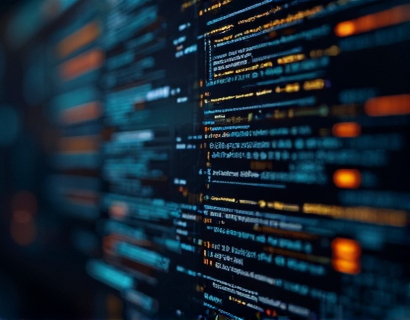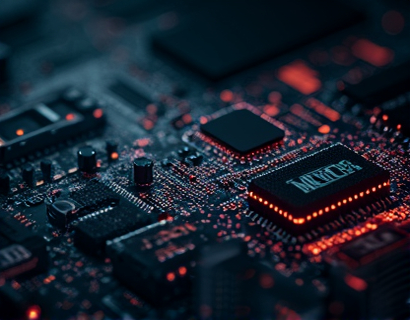Advanced Layer 2 Solutions: Empowering EVM-Enabled Blockchain Development for Scalability and Security
In the rapidly evolving landscape of blockchain technology, Layer 2 solutions have emerged as a pivotal advancement, particularly for EVM-enabled blockchains. These solutions are designed to enhance scalability, security, and efficiency, enabling the development of faster, more secure, and cost-effective decentralized applications. This article delves into the intricacies of advanced Layer 2 solutions and their transformative impact on EVM-based blockchain development.
Understanding Layer 2 Solutions
Layer 2 solutions refer to protocols and technologies built on top of existing blockchain networks, or Layer 1, to improve transaction throughput and reduce costs. Unlike Layer 1, which involves altering the core blockchain protocol, Layer 2 solutions operate within the existing framework, addressing specific pain points such as scalability and transaction fees. For EVM-based blockchains, Layer 2 solutions are crucial in maintaining the integrity and security of the network while enhancing its performance.
Key Benefits of Advanced Layer 2 Solutions
Advanced Layer 2 solutions offer several key benefits that are essential for the growth and adoption of blockchain technology:
- Scalability: By offloading transactions from the main blockchain, Layer 2 solutions significantly increase the number of transactions a network can process per second. This is particularly important for EVM-based blockchains, which face limitations in transaction throughput.
- Cost Efficiency: Transactions on Layer 2 are generally cheaper than on the main blockchain, reducing the cost barrier for developers and users. This makes decentralized applications more accessible and viable for a broader range of use cases.
- Enhanced Security: Despite operating off the main chain, advanced Layer 2 solutions maintain strong security guarantees. They often employ cryptographic techniques and consensus mechanisms that ensure the integrity of transactions and the overall network.
- Improved User Experience: Faster transaction times and lower fees lead to a better user experience, encouraging more users to adopt and engage with blockchain-based applications.
Types of Layer 2 Solutions for EVM-Based Blockchains
Several types of Layer 2 solutions are particularly well-suited for EVM-based blockchains, each with its own advantages and use cases:
State Channels
State channels allow multiple parties to conduct a series of transactions off the main blockchain, with the final state being settled on the chain. This method is highly efficient for applications requiring frequent, low-value transactions, such as gaming or micropayments. The key benefit is the significant reduction in gas fees and transaction times.
Plasma
Plasma is a scalability framework that involves creating a tree structure of child blocks attached to the main blockchain. Each child block can process multiple transactions before being finalized. This approach allows for high transaction throughput while maintaining the security of the main chain. Plasma is particularly useful for building complex decentralized applications with high user activity.
Sidechains
Sidechains are separate blockchains that are linked to the main EVM-based blockchain through two-way pegs. They allow assets to be transferred between the main chain and the sidechain, enabling off-chain transactions and smart contract execution. Sidechains are versatile and can support different consensus mechanisms and features, making them suitable for a wide range of applications.
Rollups
Rollups are one of the most promising Layer 2 solutions for EVM-based blockchains. They bundle multiple transactions into a single transaction on the main chain, significantly reducing gas costs and increasing throughput. There are two main types of rollups:
- Optimistic Rollups: These rollups assume transactions are valid and only challenge invalid transactions. They offer high throughput and low fees but require a trust period to resolve disputes.
- ZK Rollups: Using zero-knowledge proofs, ZK rollups provide stronger security guarantees by proving the validity of transactions without revealing the transaction data. This makes them more secure but slightly more complex to implement.
Implementing Advanced Layer 2 Solutions
For developers looking to leverage advanced Layer 2 solutions in their EVM-based blockchain projects, several steps and considerations are essential:
First, it is crucial to choose the right Layer 2 solution based on the specific requirements of the application. Factors such as transaction volume, cost sensitivity, and security needs should guide the decision. For instance, state channels might be ideal for applications with frequent, low-value transactions, while rollups could be better suited for applications requiring high throughput and strong security.
Next, developers need to integrate the chosen Layer 2 solution with their smart contracts and applications. This involves understanding the APIs and tools provided by the Layer 2 protocol, as well as ensuring compatibility with the EVM ecosystem. Libraries and frameworks, such as those offered by the Polygon network for rollups, can simplify this process.
Security is a paramount concern when implementing Layer 2 solutions. Developers must thoroughly test and audit their implementations to ensure that they do not introduce vulnerabilities. This includes verifying the correctness of state transitions, the integrity of off-chain computations, and the secure handling of assets during transfers.
Finally, community support and ecosystem maturity are important factors. Engaging with active communities and utilizing well-maintained tools and libraries can significantly ease the development process and ensure long-term sustainability.
Case Studies and Real-World Applications
Several projects and platforms have successfully implemented advanced Layer 2 solutions, demonstrating their practical benefits:
One notable example is the Polygon network, which provides a suite of Layer 2 solutions including rollups and sidechains. Polygon has been instrumental in scaling Ethereum-based applications, enabling projects like Axie Infinity and Decentraland to handle high user traffic with lower transaction fees.
Another example is the Raiden Network, which uses state channels to enable fast and cheap transactions on the Ethereum network. Raiden has been particularly effective in use cases such as decentralized exchanges and gaming platforms, where frequent small transactions are common.
These case studies highlight the transformative impact of advanced Layer 2 solutions in enhancing the scalability and cost-effectiveness of EVM-based blockchain applications.
Future Trends and Innovations
The landscape of Layer 2 solutions is rapidly evolving, with ongoing research and development pushing the boundaries of what is possible:
One emerging trend is the integration of Layer 2 solutions with layer 1.5 solutions, which aim to improve the base blockchain's performance without the need for a full protocol upgrade. This hybrid approach can provide a more seamless and efficient scaling solution.
Another area of innovation is the development of cross-chain Layer 2 solutions, enabling interoperability between different blockchains. This can lead to more robust and versatile decentralized applications that leverage the strengths of multiple ecosystems.
Additionally, advancements in zero-knowledge proofs and other cryptographic techniques are making ZK rollups more accessible and secure, further enhancing the appeal of rollup-based solutions.
As the blockchain industry continues to mature, the role of advanced Layer 2 solutions will become increasingly critical in driving innovation and adoption.
Conclusion
Advanced Layer 2 solutions are revolutionizing EVM-based blockchain development by addressing key challenges such as scalability, security, and cost. By offloading transactions and optimizing the use of the main blockchain, these solutions enable the creation of faster, more secure, and more cost-effective decentralized applications. As the technology continues to evolve, the potential for blockchain innovation is vast, promising a future where decentralized solutions can seamlessly meet the demands of a growing user base.










































